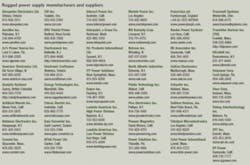Cost-sensitive military pressures power supply makers to shrink and ruggedize COTS devices
By John Keller
Manufacturers of power supplies and related power electronics for military and aerospace applications say they are under pressure to shrink device size and keep a lid on prices, as well as to ruggedize and integrate commercial off-the-shelf (COTS) components.
This should not come as a big surprise, yet power supply makers are keeping a close eye on projected downward trends in U.S. military spending, and realize that the systems integrators—their customers—will increase pressure on them in coming days to reduce costs.
“The drivers today are still pretty much small size and volume, and cost,” says William Standen, vice president of marketing and sales for Martek Power in Torrance, Calif. “If I had to pick one, I think cost is nosing out size. There is not a lot of money for defense, but the services want a lot of ability, and the services continue to want more electronics. It has put some pressure on price, in my estimation.”
Engineers at Martek Power are trying to keep costs in check while enhancing their product offerings by integrating COTS components and devices into custom subsystems designed to withstand the physical rigors of military operations.
“We see a lot of opportunities for putting the power modules in a box,” Standen explains. “This has built up on its own as an alternative to custom products. Customers ask if we can take our off-the-shelf products and integrate them.”
This phenomenon of using COTS designs for military power subsystems integration also is a factor at Falcon Electric Inc. in Irwindale, Calif. “We are seeing a trend with a lot of new advancements in commercial technologies based around computers like the PC,” says Michael Stout, vice president of engineering at Falcon Electric. “We are seeing a lot of requirements for 400 Hz aircraft power, but based on the 60 Hz U.S. commercial power frequency.”
Falcon Electric recently supplied ruggedized power devices to the U.S. Federal Aviation Administration (FAA) that convert 400 Hz aircraft power to commercial 60 Hz power for use with commercial-grade electronics, Stout says. “We have to supply them with a large frequency converter to provide that power.”
Stout says engineers also are being asked to ruggedize COTS-grade power equipment to meet military standards.
Price is not the only driver in the power supply business, however. Size, weight, and heat management—as ever—are still in the forefront of designers’ minds. Increasing demands for power in complex embedded military and aerospace systems is driving power engineers to design ever-smaller and lighter devices to satisfy industry demands.
“Power supplies must get smaller and smaller,” says Ron Storm, vice president of sales and marketing at Behlman Electronics, a division of Orbital International Corp. in Hauppauge, N.Y. “We are working on a unit that will go on the deck of an unmanned surface craft, which needs to be sealed with some sort of heat exchanger to remove the heat, where we have to deal with humidity and salt spray.”
Storm says this power unit will be sealed, and cooled with a liquid flow-through base plate, and built to withstand shock and vibration. “We need to put more in a smaller package, and you have to remove the heat,” Storm explains.
When it comes to cooling, Storm says systems integrators increasingly are willing to trade smaller unit size for the addition of a cooling base plate. “Only because they want more equipment in small spaces are people willing to give you the cold plate to keep the unit small,” he says.
null

